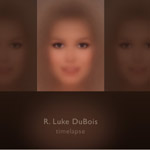|
|
 |
Dusted Reviews
Artist: R. Luke DuBois Album: Timelapse Label: Cantaloupe Review date: Nov. 12, 2006 |

|
|
|
 |
Time-lapse photography has been around nearly as long as the motion picture itself. First used by Georges Méliès in 1897, it involves recording the image at a rate much slower than the playback rate, making time appear to pass by much faster than in reality. In many ways, the time-lapse is revelatory, allowing us to observe things in motion that would otherwise go unnoticed. Transferring this concept to sound, though, is a tricky proposition. By its very nature as an active medium, vision allows us to view things in discreet slices, hence the drawing, painting, photograph, and even screen capture. Even film is just a series of discreet moments played back at such a rate that our mind interpolates the motion, in a sense, creating it out of nothingness. Sound is related to motion, created by vibrations that cause compression waves in the air that our ears passively gather and perceive as sound. As a result, it is impossible to “freeze” a sound, since that would merely be a position, and could only be perceived as an image. Digitally sampled sound can thus be conceptualized as a series of images, albeit remarkably simple images, strung together at such a rate that our ears “see” them as a sound (and, to extend the metaphor possibly a bit too far, analog sound could be the blob trails people leave in Donny Darko or, alternately, the photographic blurs that result from keeping a shutter open too long).
So how, then, would one create time-lapse phonography? You couldn’t take samples from a sound at select intervals, as that would most likely leave you with white noise. You couldn’t just speed up an existing recording, because that’s not really what a time-lapse is. And even with that problem figured out, what would you do a time-lapse of? Enter Luke DuBois. His solution: take the average of the sound, that is, look at the frequency spectrum of each moment of sound and take the mean over the entire duration. What he’s left with is a snippet of sound that combines all the characteristics of the sound as a whole. It’s kind of like vocoding time, and he interestingly compares it to long-exposure photography.
Dubois’s main target on this CD is American pop culture, specifically the No. 1 single, in a composition called “Billboard.” He takes each No. 1 on the Billboard singles chart from 1958 to 1999, condenses it down to a single second, and plays it a second for each week it was on the chart. The result is an ambient blur that is constantly cutting from one type of blur to another. It’s nearly impossible to pick out the individual songs, except perhaps for the ones that stayed at No. 1 for weeks and weeks on end, whose blurs stick around longer. What is fascinating, though, is hearing how the spectra change, sometimes low, sometimes high, sometimes loud, sometimes soft. It won’t make you tap your feet, but it does have a certain womb-like warmth to it. It’s almost the direct opposite of Hugo Keesing’s “CHARTSWEEP,” which does the same thing, except playing chunks from the song rather than averages. The effect is remarkably different.
But I’m a bit more intrigued by the other pieces on Timelapse. On “Clavier,” Dubois takes the average of each prelude and fugue from the first two books of J.S. Bach’s Well Tempered Clavier and gives it the same treatment, giving each prelude and fugue three seconds to speak. The piano is instantly recognizable, and, what’s more, the process of averaging actually leaves you with a general sense of key. Hence, the prelude and its related fugue have the same general sound, with the tone color changing from one to the other. Finally, DuBois takes the average of Casablanca in “...Time Goes By.” Instead of condensing the movie into a small bit, he seems to progress over the movie with a magnifying glass. This probably comes the closest to realizing the idea of a time-lapse for sound, since you can tell that there is talking, you can occasionally hear snatches of music, and the sense of progression over time is clear. Not to mention that it’s the most coherent, almost sounding like a Brian Eno ambient work at times.
But it also reveals the shortcomings of the concept. It’s impossible to tell you’re listening to Casablanca without being told, contradicting the revealing power of time-lapse photography. DuBois is right that the technique is much more aligned with long-exposure than time-lapse. Timelapse just makes for a better title.
By Dan Ruccia
|







